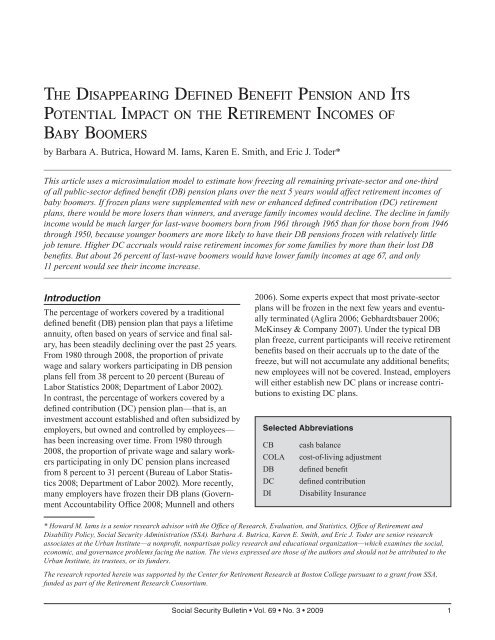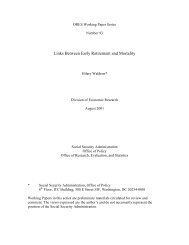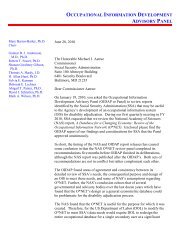Download entire publication - Social Security
Download entire publication - Social Security
Download entire publication - Social Security
You also want an ePaper? Increase the reach of your titles
YUMPU automatically turns print PDFs into web optimized ePapers that Google loves.
The Disappearing Defined Benefit Pension and ItsPotential Impact on the Retirement Incomes ofBaby Boomersby Barbara A. Butrica, Howard M. Iams, Karen E. Smith, and Eric J. Toder*This article uses a microsimulation model to estimate how freezing all remaining private-sector and one-thirdof all public-sector defined benefit (DB) pension plans over the next 5 years would affect retirement incomes ofbaby boomers. If frozen plans were supplemented with new or enhanced defined contribution (DC) retirementplans, there would be more losers than winners, and average family incomes would decline. The decline in familyincome would be much larger for last-wave boomers born from 1961 through 1965 than for those born from 1946through 1950, because younger boomers are more likely to have their DB pensions frozen with relatively littlejob tenure. Higher DC accruals would raise retirement incomes for some families by more than their lost DBbenefits. But about 26 percent of last-wave boomers would have lower family incomes at age 67, and only11 percent would see their income increase.IntroductionThe percentage of workers covered by a traditionaldefined benefit (DB) pension plan that pays a lifetimeannuity, often based on years of service and final salary,has been steadily declining over the past 25 years.From 1980 through 2008, the proportion of privatewage and salary workers participating in DB pensionplans fell from 38 percent to 20 percent (Bureau ofLabor Statistics 2008; Department of Labor 2002).In contrast, the percentage of workers covered by adefined contribution (DC) pension plan—that is, aninvestment account established and often subsidized byemployers, but owned and controlled by employees—has been increasing over time. From 1980 through2008, the proportion of private wage and salary workersparticipating in only DC pension plans increasedfrom 8 percent to 31 percent (Bureau of Labor Statistics2008; Department of Labor 2002). More recently,many employers have frozen their DB plans (GovernmentAccountability Office 2008; Munnell and others2006). Some experts expect that most private-sectorplans will be frozen in the next few years and eventuallyterminated (Aglira 2006; Gebhardtsbauer 2006;McKinsey & Company 2007). Under the typical DBplan freeze, current participants will receive retirementbenefits based on their accruals up to the date of thefreeze, but will not accumulate any additional benefits;new employees will not be covered. Instead, employerswill either establish new DC plans or increase contributionsto existing DC plans.Selected AbbreviationsCBCOLADBDCDIcash balancecost-of-living adjustmentdefined benefitdefined contributionDisability Insurance* Howard M. Iams is a senior research advisor with the Office of Research, Evaluation, and Statistics, Office of Retirement andDisability Policy, <strong>Social</strong> <strong>Security</strong> Administration (SSA). Barbara A. Butrica, Karen E. Smith, and Eric J. Toder are senior researchassociates at the Urban Institute—a nonprofit, nonpartisan policy research and educational organization—which examines the social,economic, and governance problems facing the nation. The views expressed are those of the authors and should not be attributed to theUrban Institute, its trustees, or its funders.The research reported herein was supported by the Center for Retirement Research at Boston College pursuant to a grant from SSA,funded as part of the Retirement Research Consortium.<strong>Social</strong> <strong>Security</strong> Bulletin • Vol. 69 • No. 3 • 2009 1








